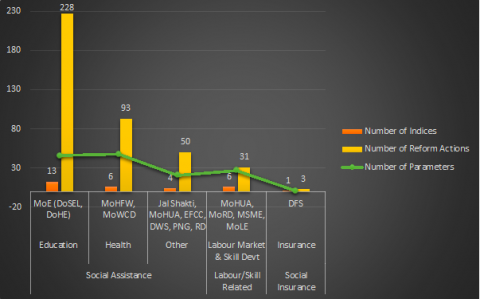Improving Social Protection in India – Leveraging Global Indices for Reforms
In seventy-five years of independence, India has embarked on an eventful journey to transgress the legacy of colonial rule and address the challenges of state capacity, poverty and hunger in order to improve the distribution of prosperity, and improve the quality of life of citizens. As a newly independent republic with high levels of poverty (45% by some estimates), and low literacy at 12% and we inherited the two headed hydra of inequality and poverty. We have come a long way since then, and today India ranks among the top 25% of countries in Climate Change Performance Index, Financial Development Index and Network Readiness Index. It has improved its performance in Ease of Doing Business, Global Innovation and Globalisation Indices.
However, we still have a long way to go in creating a level playing field. India ranks in the bottom 50% of countries in Indices critical to key development challenges, such as Global Gender Gap, Gender Inequality, Human Development, Human Capital and Multidimensional Poverty Index. Sustainable Development Goal 1 aims to eradicate poverty in all its forms via the creation of social protection systems (goal 1.3). In India, with less than a decade to go towards the 2030 deadline, it becomes integral to boost progress and propose reforms.
One perspective towards an “all of government” approach to social protection is through the Global Indices for Reforms and Growth (GIRG) project steered by the Government of India which monitors performance on thirty selected Global Indices to drive reforms across 19 Nodal Ministries/ Departments, 46 Line Ministries/ Departments and all State Governments. With the Development Monitoring and Evaluation Office (DMEO) at NITI Aayog as its knowledge partner, GIRG intends to identify systemic reforms in policies and processes to improve last mile delivery to improve quality of life, enabled by a dashboard to track progress over time.
Social protection consists of three aspects. The first is Social Assistance for the most vulnerable, which includes cash transfers, school feeding and food distribution. The second is Social Insurance, which consists of preventive measures such as age and disability pensions. The third includes promotional measures in the field of jobs and skill development, such as flagship skilling schemes including Pradhan Mantri Kushal Vikas Yojana among others.
These three aspects are embedded within GIRG, with more than 3000 parameters in indices relevant to Industry, Economy, Development and Governance. More than 900 Reform actions across 22 indices are closely relevant to social protection in India, with parameters mapped to union ministries in social assistance for health, education, and social insurance. With the greatest number of reforms in social assistance for education and health, the project also promotes systemic
improvements in labour market outcomes and skill development with government ministries and departments as key stakeholders in implementation.
For example, for Indices such as Human Development, Human Capital, Gender Gap and Multidimensional Poverty, where significant emphasis is on education related progress, reform actions across states focus on initiatives to improve foundational literacy, girls’ retention in schools, identification of out of school children, resource augmentation and early childhood care and education. Some include a capacity building programme “Nishtha” for teachers, a household survey to identify out of school children by States and UTs with the help of an app in the local language, preparation of school, block and district wise fact sheets to analyse causative factors leading to dropout and poor learning levels, among others.
Similarly, for indices where skill development is key, reform actions range across capacity building initiatives to improve the share of women being trained in states, setting up skill development centres in LWE districts, special driver skill training to reduce time delays in shipments, among others pertaining to Gender Inequality Index, and Logistics performance index.
In addition to sector specific reforms which directly fall within the category of preventive, promotional or protective instruments, The GIRG project also includes reforms which do not fall into these categories but act as enablers. These include reforms linked to infrastructure in roads, ports, railway connections, electricity access, business ease, market competition, and governance processes such as levels of corruption, transparency, rule of law, and political stability.
Weaving an effective social protection architecture must be a multi- pronged approach consisting of data systems which speak to each other, effective coordination between different Ministries and Departments, spaces of bottom-up social accountability in scheme design and well incentivised and paid functionaries. There are several lessons which can be derived from Turkey, Kenya and Chile’s social protection systems and pilots in the Indian context, such as Karnataka’s Kutumba programme, Haryana’s Parivar Pehchan Patra, Rajasthan’s Jan Aadhar programme.
For India, the path forward for social protection includes deeper thinking towards the bridging of silos across government departments, the creation of a working group to build a basket of social protection schemes, embedding monitoring and evaluation systems in scheme design and delivery to keep learning, and a long-term assessment on impacts of the combination of social services offered. The GIRG initiative intends to take a step in that direction to allow for inter-ministerial coordination and involvement within the federal structure of India, through the active involvement of state governments. The time to design effective safety nets is now.

Disclaimer: Views expressed are personal.
 GOVERNMENT OF INDIA
GOVERNMENT OF INDIA
